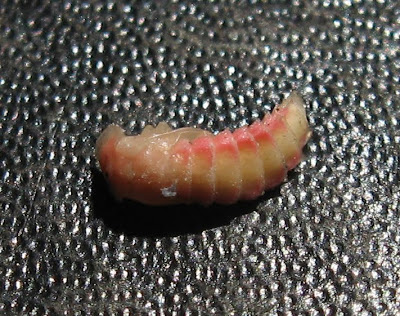A large, robust spider, the female Black and Yellow Argiope can attain a length of about 25 mm, the considerably smaller males, as is often typical among spiders, are only about 5 mm long. To date, a Cicada or Dogday Harvestfly is the largest prey I have ever seen one of these spiders take down.
Saturday, August 18, 2012
Black and Yellow Argiope (Argiope aurantia)
Tuesday, August 14, 2012
Tricky Tick Trefoils, Flowering Fabaceae and Leafy Legumes
Magnificent in magenta, groups of eye-catching Tick Trefoil can be found blooming in sunny locations along the Moira River shoreline during the first week of July. After consulting the species accounts in my field guides and various Internet sources I decided that the plants' attributes were consistent with Showy Tick Trefoil (Desmodium canadense).
Tick Trefoils are best distinguished by their loments (the pod-like fruits) so I re-visited the site where the plants in the photos above were growing, and unfortunately there was no sign of any fruits.
Friday, August 10, 2012
Sharing the Risks and Dividing the Dangers
A quote from the preamble to the U.S. Constitution sums up the idea of Müllerian mimicry very well – "We the people ... in order to ... provide for the common defense, promote the general welfare ..."
Müllerian mimicry is named in honour of the German naturalist Fritz Müller, who first observed and offered an explanation for the phenomenon. Simply put, several species, not necessarily related, that have predators in common will also tend to mimic each other and share aposematic colors or warning signals. Of course, unlike the U.S. model there's no conscious or intelligent decision to co-operate, and the mutations that eventually give rise to a given defensive game plan are random – but the process of natural selection is not. A given shared color scheme benefits and promotes the survival of all the individuals within the species that share it, and it's survivors that (naturally!) hand their genes down for another roll of the dice to the next generation.
Members of the order Hymenoptera that can sting tend to exhibit bold black-and-yellow stripes. A child, a bird, or a frog that has been stung by a Honeybee will likely remember the painful experience and in future also avoid a Bumblebee, a Paper Wasp and a Mason Wasp – the individual Honeybee (a non-reproductive worker in any event) loses, but its relatives and the other Hymenopteran species gain a measure of immunity from predation.
Wednesday, August 8, 2012
Coleopteran Conundra
The change of form among insects that undergo complete metamorphosis is astounding, and it's difficult to believe that the egg, larva, pupa and adult are really one and the same insect.
Pupae are often thought of as a dormant and inactive but these little guys, found in moist soil under a rock along a riverbank, were quite lively when disturbed. Given the habitat, a species of diving beetle seemed to be a reasonable guess but I really had no idea as to family, let alone genus or species, so I submitted the images to BugGuide.Net for an ID.










































































